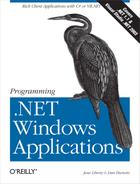- Programming .NET Windows Applications
- A Note Regarding Supplemental Files
- Copyright
- Preface
- 1. Windows Forms and the .NET Framework
- 2. Getting Started
- 3. Visual Studio .NET
- 3.1. Overview
- 3.2. Start Page
- 3.3. Projects and Solutions
- 3.4. The Integrated Development Environment (IDE)
- 3.5. Building and Running
- 4. Events
- 5. Windows Forms
- 6. Dialog Boxes
- 7. Controls: The Base Class
- 7.1. Control Class
- 7.1.1. Class Hierarchy
- 7.1.2. Common Features
- 7.1.2.1. Parent/child relationship
- 7.1.2.2. Z-order
- 7.1.2.3. Changing the z-order
- 7.1.2.4. Ambient properties
- 7.1.2.5. Font
- 7.1.2.6. Size and location
- 7.1.2.7. Dynamically setting size and location
- 7.1.2.8. AutoScale
- 7.1.2.9. Anchoring
- 7.1.2.10. Docking
- 7.1.2.11. Painting the control
- 7.1.2.12. Tag property
- 7.1.2.13. Tabbing
- 7.1.2.14. Keyboard interaction
- 7.1.2.15. ImageLists
- 7.1. Control Class
- 8. Mouse Interaction
- 9. Text and Fonts
- 9.1. Text
- 9.2. Fonts
- 9.2.1. Typographical Stuff
- 9.2.2. Font Class
- 9.2.2.1. Font properties
- 9.2.2.2. Constructors
- 9.2.2.2.1. Constructor based on existing font and FontStyles
- 9.2.2.2.2. Constructor based on FontFamily and size
- 9.2.2.2.3. Constructor based on FontFamily, size, and FontStyles
- 9.2.2.2.4. Constructor based on FontFamily, size, and GraphicsUnit
- 9.2.2.2.5. Constructor based on FontFamily, size, FontStyles, and GraphicsUnit
- 9.2.2.3. Line spacing
- 9.2.3. Drawing Strings
- 9.2.4. Measuring Strings
- 10. Drawing and GDI+
- 10.1. The Drawing Namespace
- 10.2. The Analog Clock Project
- 11. Labels and Buttons
- 12. Text Controls
- 13. Other Basic Controls
- 14. TreeView and ListView
- 15. List Controls
- 16. Date and Time Controls
- 17. Custom Controls
- 18. Menus and Bars
- 18.1. Creating Your First Menu
- 18.2. The MainMenu Object
- 18.3. Toolbars
- 18.4. Writing It by Hand
- 18.5. Status Bars
- 19. ADO.NET
- 19.1. Bug Database: A Windows Application
- 19.2. The ADO.NET Object Model
- 19.3. Getting Started with ADO.NET
- 19.4. Managed Providers
- 19.5. Binding Data
- 19.6. Data Reader
- 19.7. Creating a DataGrid
- 20. Updating ADO.NET
- 21. Exceptions and Debugging
- 22. Configuration and Deployment
- 22.1. Class Hierarchy
- 22.2. Configuration
- 22.3. Assemblies
- 22.4. Build Configurations
- 22.5. Deployment
- A. Characters and Keys
- About the Authors
- Colophon
- Copyright
Windows Forms is the name Microsoft gave to its desktop development technology. Using Windows Forms, it is easier than ever to create applications that are dynamic and data-driven, and that scale well. Used in conjunction with Visual Studio .NET, Windows Forms technology allows you to apply Rapid Application Development (RAD) techniques to building Windows applications. Simply drag and drop controls onto your form, double-click on a control, and write the code to respond to the associated event. In short, the RAD techniques previously available only to VB.NET programmers is now fully realized for all .NET languages.
You can program Windows Forms in any language that supports the .NET Common Language Specification (CLS). The examples in this book will be given in C# and VB.NET. We believe that C# and VB.NET are very similar, and if you know one you will have no problem with examples shown in the other. That said, we offer the examples in both languages to simplify the process of learning the technology.
Since all Windows Forms source files are plain text, you can develop all your applications by using your favorite text editor (e.g., Notepad). In fact, many examples in this book are presented just that way. However, Visual Studio .NET offers many advantages and productivity gains. These include the items listed next.
Visual development of Windows Forms
Drag-and-drop Windows controls
IntelliSense and automatic code completion
Integrated debugging
Automated build and compile
Integration with the Visual SourceSafe source control program
Fully integrated and dynamic help
-
No Comment
